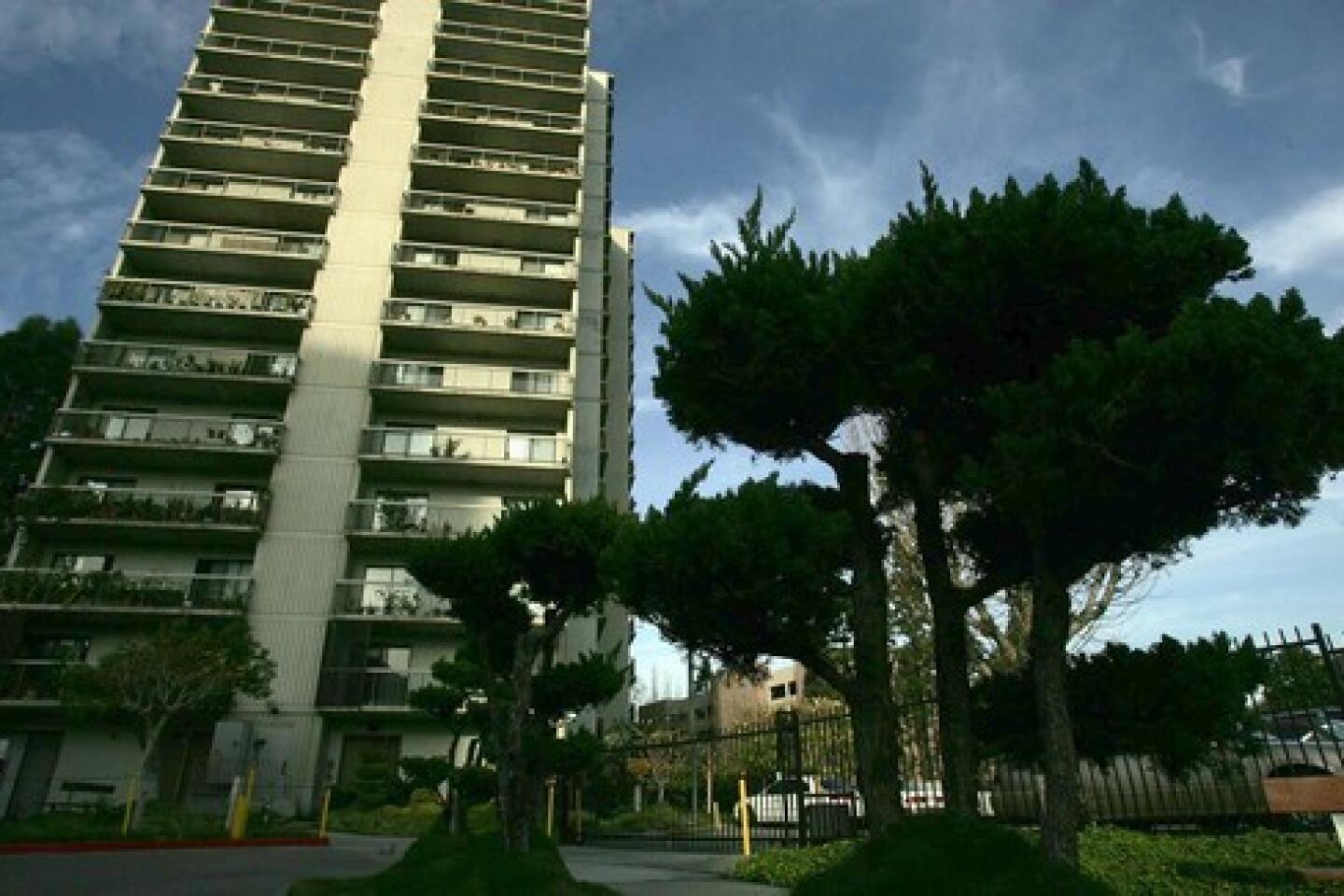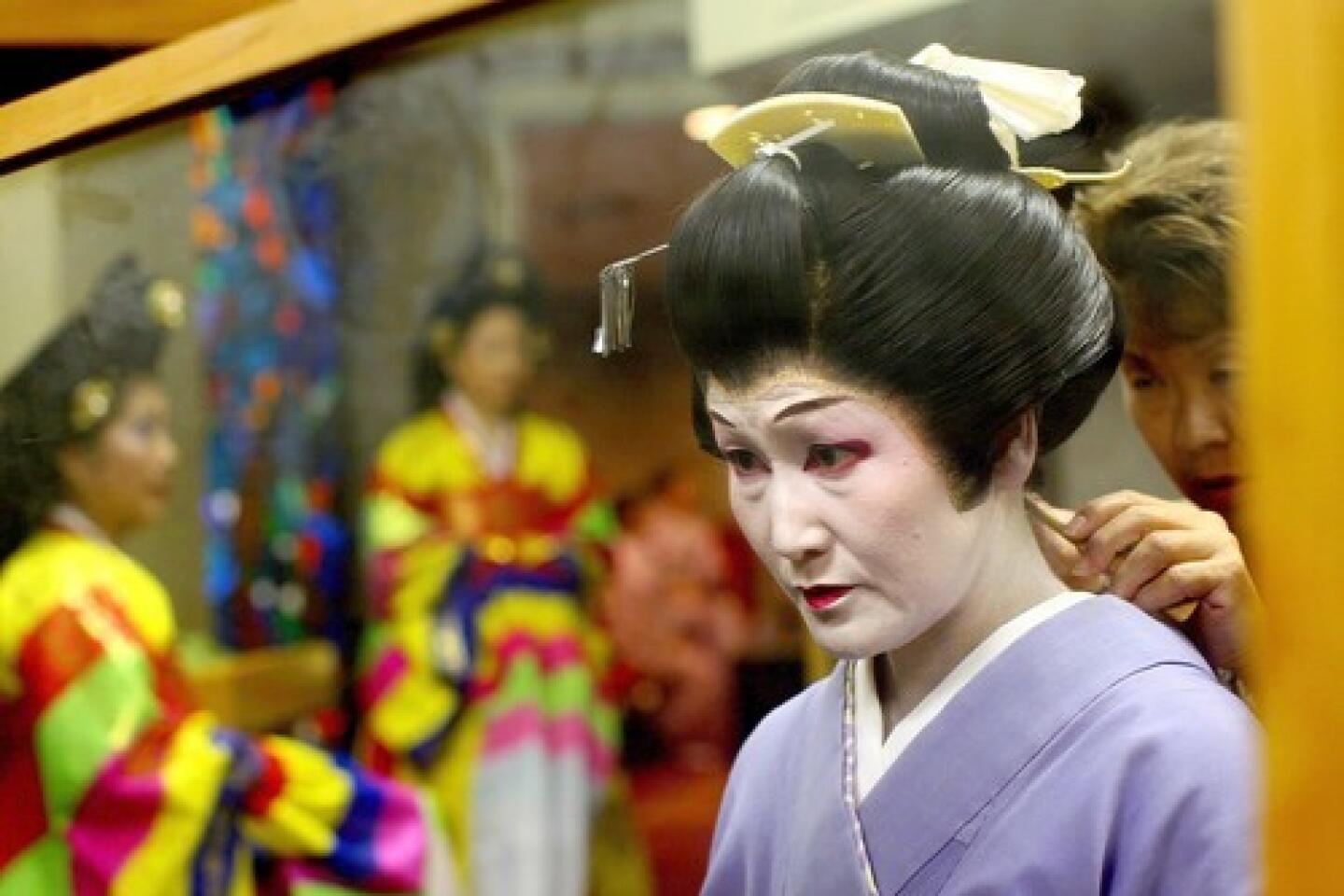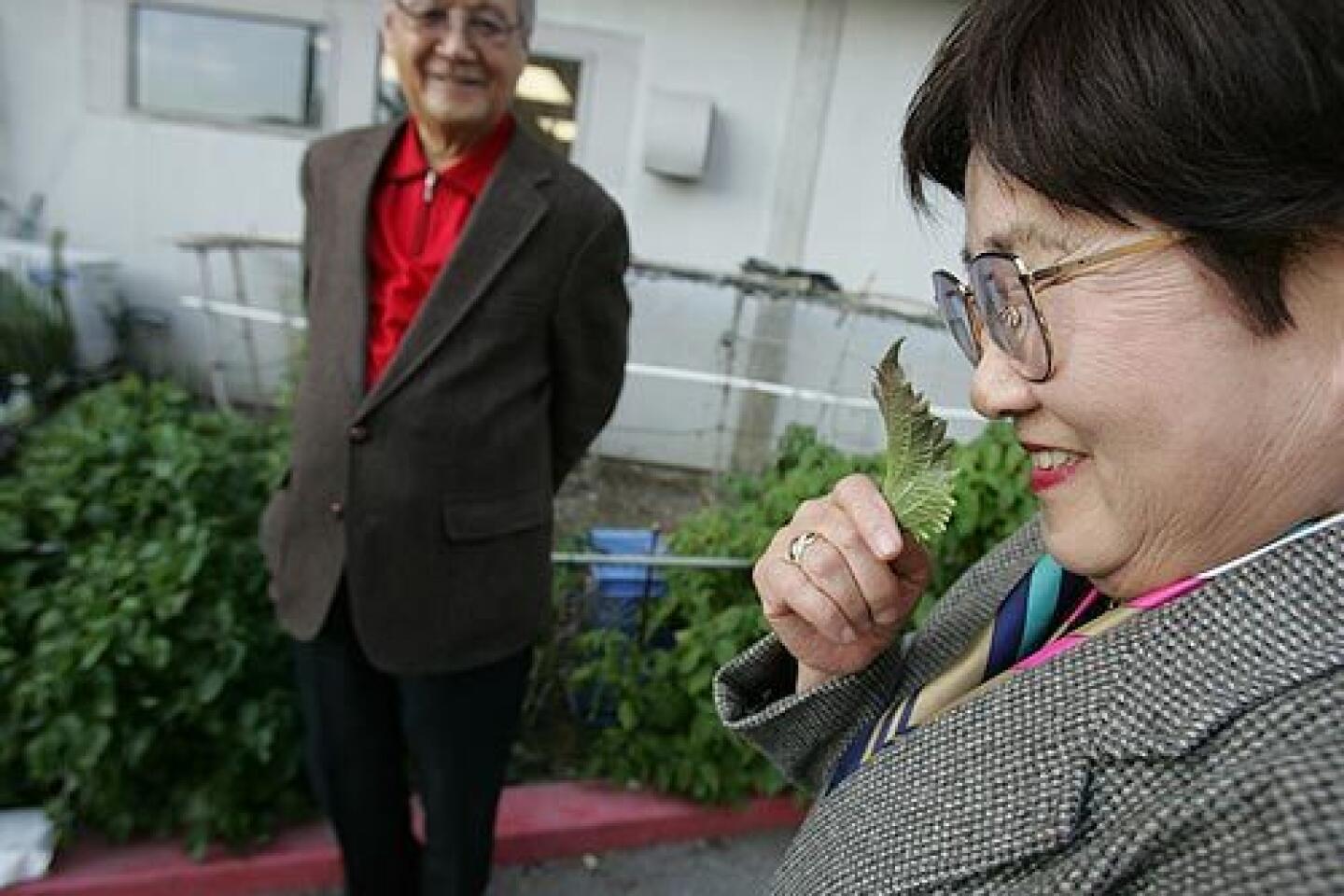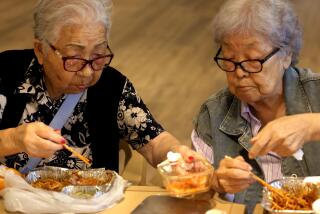Japanese and Koreans learn to live together in harmony in L.A.’s Little Tokyo
Hongsun Kim has heard it all. When the number of Koreans began multiplying in Little Tokyo Towers a few years ago, complaints about them from Japanese residents quickly began to surface, the Los Angeles social worker said.
“They smell of garlic.” “They don’t follow the rules.” “They’re going to take over.” Then, from the Koreans: “The Japanese are snooty.” “They don’t greet you in the elevator.” “They disdain Korean culture.” “They’re trying to push us out.”
As Korean residents and shop owners have increased their presence in Little Tokyo, the historic heart of Southern California’s Japanese American community, the multicultural melding hasn’t always been harmonious. Today, however, the tone in the towers -- a 300-unit senior housing facility on 3rd Street -- is strikingly different.
A Korean resident whose relatives were jailed for protesting Japan’s colonization of his motherland is teaching his native language to a dozen of his Japanese neighbors. “Ga, gya, go, gyo,” they intently repeated on a recent night, mimicking the sounds of the Korean alphabet as teacher Simon Yoon pointed them out on a whiteboard.
Residents recently held a New Year’s party and debuted a Korean-Japanese bilingual newsletter called “Bridges” to share their cultures. On other nights, they belt out songs in both languages using a karaoke machine purchased by Korean residents -- who took care to include 2,500 Japanese songs. And in August, they attended a groundbreaking “harmony concert” featuring Japanese and Korean music and dance.
Over the last two years, the residents of Little Tokyo Towers have made their home a case study in containing cultural conflict and building cohesion -- a challenge faced by other Los Angeles ethnic neighborhoods, where new populations are joining long-settled ones. The task is particularly delicate when it comes to Japanese and Koreans, whose motherlands are burdened with a long history of conflict stemming from territorial disputes and historical grievances related to Japan’s colonization of Korea in the early 20th century.
But the turnabout in Little Tokyo proves ethnic harmony is possible, Kim and others say.
“We want to show that in Little Tokyo, there are people who want to be good neighbors to each other regardless of the past and all of the conflicts we’ve experienced,” Kim said. “If reconciliation can happen in Little Tokyo, then it could be a model for the city and for Japan and South Korea.”
Hard-won insight
The rapprochement is led by people like Kim and Yoon, Korea natives fluent in Japanese who are able to connect with both sides.
Yoon, 86, with a genteel mien and impeccable style, grew up under Japan’s colonial rule, where he recalls being forced to bow east to the Japanese emperor every day and sit with his arms raised in punishment for speaking Korean. His father-in-law spent nearly eight years in prison for pressing for Korean independence. “I learned Japanese to fight the Japanese,” Yoon said.
But then, he said, his heart softened after a Japanese military doctor came to his village and labored to cure the local people of tuberculosis, even spending his own money on medicine for them. That, along with Christian teachings of forgiveness, compelled Yoon to work for reconciliation today.
Kim, 38, is a Christian minister and social worker who was born in Seoul and raised in Japan by his missionary parents. He arrived in Los Angeles in 1999 to work at the Little Tokyo Service Center.
But even though Kim glides easily between the Japanese and Korean languages, his own psychological journey between the two cultures hasn’t always been easy. As a Korean in Japan, he said, he always felt isolated. Yet when he returned to South Korea for compulsory military service at 23, hoping to find a full sense of belonging, he said he was derided as a “half-Jap,” beaten up and verbally abused every day in the army. The experience alienated him from his own culture and sharpened the divide he said he felt between his Korean heritage and Japanese upbringing.
But working for harmony between Korean and Japanese residents in Little Tokyo has helped him heal his own internal dissonance, Kim said.
“I recently found a connection between my inner state and the outside community,” Kim said. “One side was always asking me to get rid of the other. But once I began to feel good about being as I am, I really wanted to prove objectively that the Japanese and Korean communities can get along really well . . . in Little Tokyo.”
On the Japanese side, Kimie Takahashi has plunged into Korean-Japanese activities as a student in Yoon’s Korean class, a member of a joint “better relations” committee and a contributor to the “Bridges” newsletter. Takahashi said she was grateful for Kim’s devotion to Japanese seniors like herself -- he drives her to the hospital, for instance -- and wanted to support reconciliation activities.
The three friends, who communicate in Japanese, have had to navigate some touchy issues that began surfacing after more Koreans started moving into the towers about five years ago. Although Little Tokyo Towers has always had some multicultural residents, including Koreans, Chinese and African Americans, the population had been overwhelmingly ethnic Japanese since its development in 1975 by four Japanese American organizations.
Today, however, about one-third of the units are occupied by residents of Korean heritage, according to a Little Tokyo Service Center survey. Kim said more Koreans are moving to Little Tokyo because senior facilities in Koreatown are overcrowded, and despite historical tensions with Japanese, Koreans feel more comfortable in an Asian environment than a white or Latino one.
Contentious times
The facility’s shifting demographics have raised hackles among some Japanese Americans. The Rev. Noriaki Ito of the nearby Higashi Honganji Buddhist Temple, a towers board member, said he has fielded complaints from some community members accusing the facility’s management of taking bribes to move Koreans up the waiting list -- accusations the board investigated but found groundless, Ito said.
But Ito said fair housing laws and public subsidies prevent the board from discriminating against non-Japanese in accepting residents. “It’s a difficult tightrope we’re walking on,” he said.
The growing complaints soon reached the ears of Kim and others at the service center. At monthly meetings with the facilities’ leadership, the subject of the Korean influx would come up repeatedly, according to Evelyn Yoshimura of the service center.
“It was very ugly,” Yoshimura said. “People would tell us we have to take a stand against Koreans and do something or they would take over.”
The service center decided to do something -- but not what exclusionists had in mind. Two years ago, it sponsored a series of four films, two Japanese and two Korean, to share cultures and bring residents together. The idea was sparked when social workers visited a Japanese resident who often complained about Koreans -- only to see a poster of Korean drama star Bae Yong Jun in her apartment. The venture was considered a success, drawing 80 seniors who wrote in surveys afterward that the films opened their eyes to new aspects of each other’s cultures.
Meanwhile, Yoon and others had started a “Good Neighbors” group of Korean residents in Little Tokyo Towers to help smooth over conflicts. Among other things, they began the joint karaoke nights, learned basic Japanese phrases and published an in-house newsletter asking Korean residents not to leave jars of kimchi outside their doors because Japanese weren’t used to the smell.
Yoon went further, growing vegetables such as shiso, or chrysanthemum leaves, for Japanese residents who like to cook with them. He recently began offering the Korean-language classes, drawing a dozen students.
During a recent class, Takahashi scribbled down notes on the Korean alphabet and demonstrated her command of simple phrases such as kamsamnida, or thank you.
“Koreans are increasing in Little Tokyo, and if we can’t speak with each other, we can’t understand each other,” she said.
About a year ago, Takahashi, Yoon and others formed the Little Tokyo Korean and Japanese Better Relations Committee. Their first major venture was the newsletter, which featured Yoon’s comparison of Japanese and Korean New Year’s traditions, Takahashi’s article on the upcoming Japanese Girls’ Day festival and other pieces.
But the emotional highlight so far has been the harmony concert organized last summer by Kim and sponsored by a Japanese church association. The concert featured Japanese and Korean traditional dance and music, an Asian American jazz group and three emcees speaking Japanese, Korean and English. Kim, putting on his pastor’s hat and using the parable of the Good Samaritan, delivered a sermon about crossing boundaries to be caring neighbors.
The concert drew a full house of more than 150 people, half Korean and half Japanese. As a finale, the concertgoers held hands and recited in three languages, “Let’s meet again.”
The tensions have not entirely disappeared, and bilateral politics can easily cause tempers to flare anew. After Japan made what South Korea viewed as provocative statements last summer over disputed islets known as Takeshima or Tokdo, for instance, one Korean musician scheduled to perform at the harmony concert angrily pulled out.
But residents on both sides say the complaints about each other have markedly dropped.
“We would like people to know that there is not just conflict, but also harmony and hope,” Kim said.
More to Read
Sign up for Essential California
The most important California stories and recommendations in your inbox every morning.
You may occasionally receive promotional content from the Los Angeles Times.














